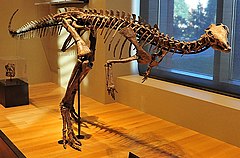Dryosaurus
|
Dryosaurus Temporal range: Late Jurassic, 155–145 Ma |
|
|---|---|
 |
|
| D. altus, Beneski Museum of Natural History | |
| Scientific classification | |
| Kingdom: | Animalia |
| Phylum: | Chordata |
| Class: | Reptilia |
| Clade: | Dinosauria |
| Order: | †Ornithischia |
| Suborder: | †Ornithopoda |
| Family: | †Dryosauridae |
| Genus: |
†Dryosaurus Marsh, 1894 |
| Species: | †D. altus |
| Binomial name | |
|
Dryosaurus altus (Marsh, 1878 [originally Laosaurus altus]) |
|
Dryosaurus (/ˌdraɪoʊˈsɔːrəs/ DRY-o-SAWR-əs; meaning 'tree lizard', Greek δρυς/drys meaning 'tree, oak' and σαυρος/sauros meaning 'lizard'; the name reflects the forested habitat, not a vague oak-leaf shape of its cheek teeth as is sometimes assumed) is a genus of an ornithopod dinosaur that lived in the Late Jurassic period. It was an iguanodont (formerly classified as a hypsilophodont). Fossils have been found in the western United States, and were first discovered in the late 19th century. Valdosaurus canaliculatus and Dysalotosaurus lettowvorbecki were both formerly considered to represent species of Dryosaurus.
Dryosaurus had a long neck, long, slender legs and a long, stiff tail. Its arms, however, with five fingers on each hand, were short. Known specimens were about 8 to 14 feet (2.4 to 4.3 m) long and weighed 170 to 200 pounds (77 to 91 kg). However, the adult size is unknown, as no known adult specimens of the genus have been found.
Dryosaurus had a horny beak and cheek teeth and, like other ornithopods, was a herbivore. Some scientists suggest that it had cheek-like structures to prevent the loss of food while the animal processed it in the mouth.
...
Wikipedia
